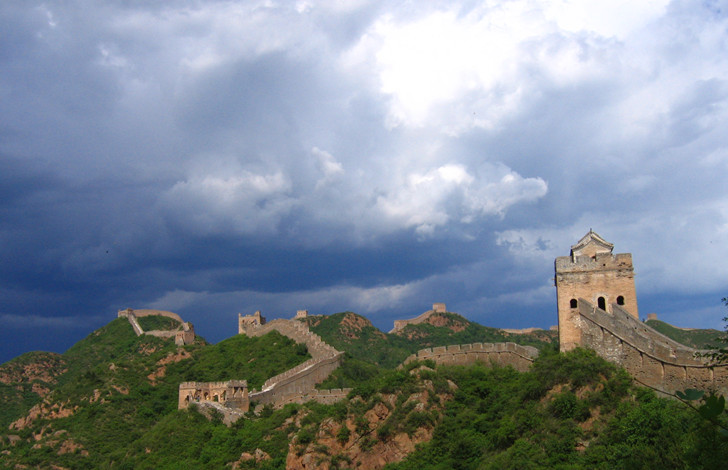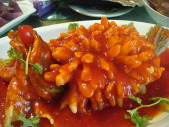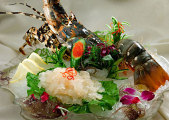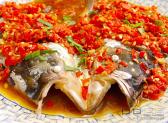
China Overview
- Population: 1.3 billion
- Currency: yuan
- Guinness World Records: most people painting each other's faces simultaneously in one location (13,413), largest bottle of cooking oil (containing 3212 litres), most couples hugging (3009 couples).
- Internet users: 135 million
- Milk beer: from Inner Mongolia, an alternative to the traditional mare's-milk wine.
- Squirrel fish: whole mandarin fish deep-fried and manipulated to resemble a squirrel.
- Number of chinese characters: over 56,000
Southern dishes
China, with over 5000 years' of culinary history, employs an immense variety of ingredients, flavors, preparation and cooking techniques in its cuisine. Geography, climate, agriculture, and culture vary greatly from region to region, giving rise to the different styles of food. |
The south South China (Guangdong, Hainan) is in the tropical and subtropical zones, with rivers, lakes, and a higher rainfall. Because of the rich resources brought by these climate and landscape factors, Southern Chinese food is characterized by the staggering variety of the ingredients used, and is widely regarded as the country’s best. In addition to produce, meats and seafood, Cantonese cuisine is known for its sometime use of ‘exotic’ ingredients. A |
|
famous proverb illustrates the variety of Cantonese food: "anything that walks, swims, crawls, or flies with its back to Heaven is edible." However, these exotic foods are not eaten that often. Guangdong food are often exaggerated and magnified by these sayings often due to the lack of understanding in foreign culinary traditions in the Western world. Guangdong cuisine stresses freshness of ingredients and corrects cooking method. Ingredients are usually prepared with a light touch, just enough cooking and seasoning to keep the original color of the material and the natural flavors of the foods. There are countless Cantonese cooking methods, steaming, stir-frying, shallow frying; double boiling, braising and deep-frying are the most popular cooking methods. The traditional Guangdong cuisine emphasizes seafood, especially various kinds of steamed fish and shellfish. Pork and duck in whole are glazed with mixtures of soy sauce, peanut oil, ginger, onion, sugar, wine, and roasted to a beautiful reddish gold. Dishes are almost always served with freshly steam rice, since rice is the staple crop of South China. | |
 | The east Eastern Chinese cuisine, found in the region of Jiangsu , Zhejiang , Shanghai and the surrounding provinces, is one of the lesser-known types of Chinese food, generally characterized as 'sweet and oily'. Not surprisingly, Seafood and freshwater fish predominates in Eastern Chinese cuisine, as the nearby ocean,Yangtze River, numerous lakes and river tributaries provide abundant |
fish, shrimp, and shellfish to this region. Steaming, stewing, braising and frying are the most common forms of Eastern Chinese cooking. This school uses sugar, vinegars and wines to provide sweet tastes and create subtlety of flavor. "Shanghainese" cuisine is known for its hodgepodge and diversity in China. The hundreds of different regional and village recipes were brought into the dominant port city of Shanghai. Shanghai cuisine also incorporates some foreign influence because of European presence in the 19th and 20th centuries. There are Shanghai-style zakuski (Russian cold appetizers), French-style cakes and pastries. A Shanghainese menu can be an assortment of different styles and often contains Sichuan, Guangdong, and Northern China dishes. Shanghai Sautéed Crabs with Sour Sauce and Stewed meat ball, Suzhou's Sweet and Sour Mandarin Fish? and succulent Chinese ham in honey sauce, Nanjing's pressed duck, Wuxi's sweet-and-sour pork spare ribs, Hangzhou's quick-fried shredded eel? or Beggar's Chicken), the list is endless. | |
The west Sichuan Szechuan and Hunan cuisines are the most famous in China's western regional school of cooking, which are primarily known for their hot and spicy dishes. Many Chinese Szechuan and Hunan restaurants overseas serve some version of Sichuan and Hunan food, but they are really just a pale comparison to the authentic things. Red chilis are used in many dishes, often rivaling that of Mexican or Thai preparations. |
|
The reason for this emphasis on spice may derive from the region's hot, humid climate as well as its hundreds of years' independent culture from other parts of China. The climate also contributes to the necessity of sophisticated food-preservation techniques which include pickling, salting, drying and smoking. However, there is more to the Szechuan and Hunan food than spice and sauces rich and strong in flavor. There is a large portion of recipes that use little or no spice at all, such as "Tea Smoked Duck". | |
All Topics about China
- General-China-Introduction
- C2-Chinese-History
- Chinese-Religions
- Chinese-Food-and-Drink
- Chinese-Literature
- Chinese-Nationality
- Chinese-Architecture
- Chinese-Arts-and-Crafts
- Chinese-Language-and-Education
- Chinese-Medicine
- Chinese-Transportation
- Chinese-Festival
- Chinese-Astrology-and-Zodiac
- Chinese-Calendar
- Chinese-Traditional-Sports-&-Activities
- Chinese-Martial-Arts
HOTMost Popular Topics
Climate in China
Because of its size, China has great climatic diversity. Generally, the best time to visit China is during spring and autumn.
Chinese-Language-and-Education
Chinese is the most commonly used language in China, and one of the most commonly used languages in the world.
Chinese-Festival
China has many traditional festivals, including the Spring Festival, the Lantern Festival, the Dragon Boat Festival.
Chinese Chinese-Astrology-and-Zodiac
In the Chinese zodiac, twelve animals are used to denote the year of a person's birth: rat, ox, tiger, rabbit, dragon.
History of China
China, one of the world's most ancient civilizations, has a recorded history of nearly 4,000 years..









